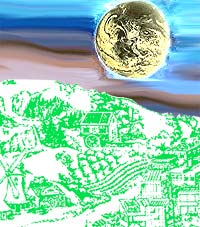|
from 26 feb 2006 ESEI vol 1, #4 |
|
An Introduction to Permaculture 
by Larry Santoyo Through the simple and practical strategies offered by Permaculture Design, a village lifestyle like this is not a dream. Permaculture mimics nature -where total resource efficiency is accomplished by managing waste for productivity and balancing its consumption with contributions from each of the elements in the system. Permaculture brings to home owners and design professionals an innovative approach to planning, landscaping, building and retrofitting. Coined by Australian ecologists Bill Mollison and David Holmgren, "Permaculture" is a contraction of the words "permanent and culture". It is a highly developed Art, Science and Philosophy. Regional groups and colleges teach Permaculture Design, and design firms throughout the country are now offering Permaculture services. Permaculture Design sciences are now used by homeowners, architects, land use planners, landscape designers, farmers and community service organizations world wide. Permaculture courses train designers in simple techniques to "read the patterns of the landscape" and methods that turn problems into resources. Permaculture designers consider that every property has a unique pattern of natural characteristics. Proper alignment with these natural patterns is the basis of the permaculture process. Using Permaculture Design, human ecosystems (development) can model nature's patterns of multi-functionality and inter-connectivity, making it as sustainable and resilient as a forest system. Instead of the "one size fits all" approach, Nature is allowed to direct the land use plan. By skillfully using permaculture methods of site analysis and evaluation, elements (such as buildings and roads) and practices (such as farming and forestry) are established only in areas with optimum conditions - working with nature in an efficient and economical way. Elements are placed not in isolation, but in relation to the dynamics of the total site. Proper placement is achieved when an element or a practice is designed to interact efficiently with all of the influencing elements. To do this, permaculture designers use simple physics and biology, as well as specific observation skills. The permaculture designer treats the built environment and the natural environment as a whole. Houses are designed not only for optimum solar advantage but are carefully sited away from sensitive areas. Prime agricultural land and wildlands are protected. Precautions are taken for the predictable threats of fire, flood, wind, and cold air drainage. One of the primary objectives in permaculture is for designers to develop simple biological alternatives to reduce the need for the expensive and resource consuming demands of high technology. (Proper shading alone can reduced cooling costs even in desert areas by 20% or more.) Permaculture designers also learn to observe and research naturally occurring plant and animal assemblies (guilds). This information is translated for use in sustainable farming. Perennial fruit trees, shrubs, and vines, together with livestock and commercial crops, are selected to mimic natural assemblies - each plant and animal benefits the other, providing a permanent and maintenance free resource system. Comprehensive water and soil conservation planning are integral to any sustainable design. For water conservation and flood controls, permaculture designers use roofs of buildings, parking lots, roadways and landscapes for harvesting run-off water. Basin and berm structures (swales) and cisterns are constructed to collect this run-off water and convert flooding problems into helpful resources of drinking water and low cost irrigation. For economic development, Nature's model of resource efficiency is used again. Creating community development plans is probably Permaculture Design's best application. In this process an inventory is meticulously prepared, examining a community's basic needs and cross-referenced with its renewable resources. Needs that are not met by local resources are considered job opportunities for the community. Only those resources surplus to local needs are made available as sustainable commodities for sale and trade - thus creating a stable economy based on real need and renewable resources. "Mixed use" zoning closely mimics natural systems and is highly recommended for community land use plans. Designing residential and commercial zones as clusters allows large areas of open and wild spaces to remain intact. This creates an access-by-proximity design allowing people to live, shop, work and recreate in the same general area. Transportation and traffic problems are greatly reduced. Suburban and urban consumers can also help conserve resources and link directly with nearby farms and other rural enterprise. Permaculture Design offers a natural, practical and inherently economical way to model our homes and communities. Permaculture also offers hope -as it effectively bridges the gap between development needs and true ecological sensitivity. 
|
||||
|
ESEI is looking for short fiction, extracts of novels, poetry, lyrics,
polemics, opinions, eyewitness accounts, news, features, information and arts
in any form relating to eco cultural- social- spiritual issues, events and
activites (creative and political). Send to Newsdesk. |
